Reviews of "The Eyes of Tammy Faye" and "The Ice King," along with a podcast preview, are all in the latest Movies with Meaning post on the web site of The Good Media Network, available by clicking here.
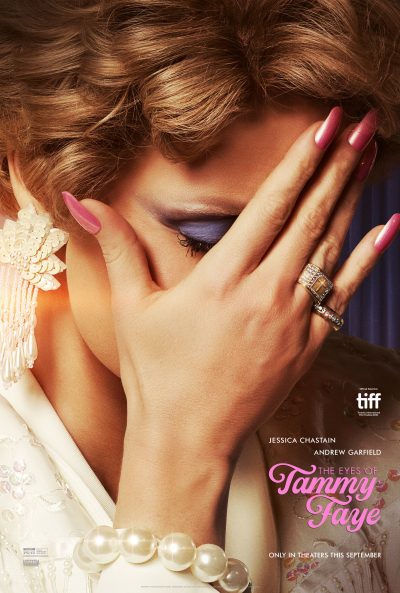
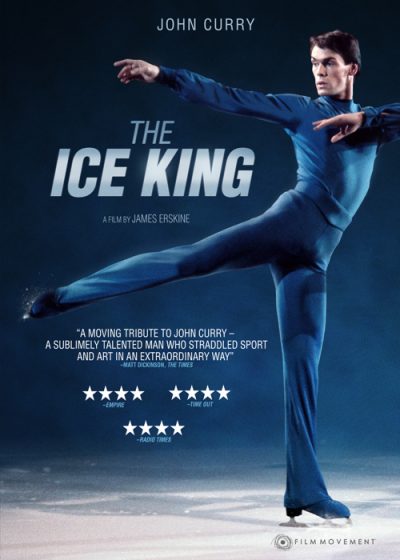
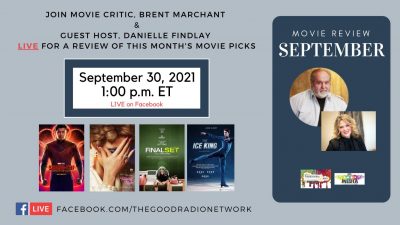

Reviews of "The Eyes of Tammy Faye" and "The Ice King," along with a podcast preview, are all in the latest Movies with Meaning post on the web site of The Good Media Network, available by clicking here.





“The Ice King” (2018). Cast: Interviews: Johnny Weir, Robin Cousins, Dorothy Hamill, Dick Button, Heinz Wirz, Rita Curry, Christa Fassi, Cathy Foulkes, Meg Streeter Lauck, Nancy Streeter, William Whitener, Elva Corrie, Nathan Birch, David Spungen, Freddie Fox (narrator). Archive Footage: John Curry, Carlo Fassi, Vladimir Kovalyov, Donald Jackson, JoJo Starbuck, Peter Martins, Twyla Tharp, Ed Mosler, Joseph Curry. Director: James Erskine. Screenplay: James Erskine. Web site. Trailer.
When faced with a seemingly insurmountable challenge, it would be easy to throw in the towel. At the same time, though, when we also know that what we wish to bring into being is something we must do, such awareness compels us to strive ever forward, regardless of the effort and cost involved. But how can that be accomplished? It helps to have a vision and the persistence necessary to flesh it out, qualities depicted in the inspiring sports documentary, “The Ice King.”
John Curry may not be a household name, but his impact was certainly considerable. After winning the British and European figure skating championships, he went on to make a name for himself as the gold medal winner at the 1976 Winter Olympics in Innsbruck, Austria, followed by the sport’s world championship, his four titles solidifying his status as a grand slam champ of the sport. As impressive as this accomplishment was, however, Curry’s greatest achievements were yet to come.
In a sport that was strongly characterized by pronounced athleticism at the time, Curry sought to turn it on its ear by making it more artistically expressive. He envisioned supplementing the sport’s high-flying jumps with graceful, fluid movements featuring dramatic, emotive gestures, an attempt aimed at adding distinctive flowing lines to the routines. While those qualities were considered acceptable for women, it was not looked upon as favorably in the men’s competitions, largely because, in the less tolerant ways of the time, such artistry was frowned upon as less than masculine and conveyed the “wrong” impression about the sport’s participants. Curry, however, who had aspired to be a dancer in his youth – an ambition looked down upon by his strict, close-minded father, Joseph – was determined to introduce it in hopes that it would help to reshape the sport and take it to a new level.
Curry worked hard for years to bring this about. Under the guidance of coaches Carlo and Christa Fassi, he honed his skills and incorporated these elements into his routines. And, by 1976, when he was ready to pursue Olympic gold, he had perfected his craft, permanently changing the nature of men’s competitive figure skating.
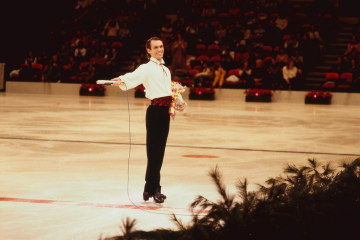
But Curry saw the Olympic title as a springboard to greater things. In preparing to turn professional, he was not content to follow the path taken by many of his figure skating peers, most of whom signed on with touring ice shows in which they were cast as performers of kitschy, cartoonish routines. As Curry put it, after years of serious artistic training, he could not envision himself putting on an ice skating routine dressed up in a Bugs Bunny costume. He wanted his professional career to reflect the sentiments that he had been longing to bring to the sport.
Curry thus established his own skating troupe, one in which he worked on developing routines that incorporated classic dance movements choreographed by such notables as Peter Martins and Twyla Tharp. His programs featured flamboyant costuming and diverse music from a variety of genres, including tangos, modern electronic compositions, and classical pieces from the likes of Claude Debussy and Erik Satie. In this way, he sought to bring the artistry to professional figure skating that fulfilled his dreams and was noticeably absent from the popular touring ice shows. This attempt at elevating the nature of the art drew widespread attention from skating peers, many of whom flocked to the opportunity to join a troupe such as this. Curry was joined by such noteworthy skating professionals as Dorothy Hamill, 1976 Olympic gold medalist and world champ, and JoJo Starbuck, bronze medalist at the 1971 and 1972 world championships.
The new look that Curry gave to figure skating drew raves, not only from fans of the sport, but also from the arts community, who relished the fresh, innovative approach he was infusing into both the skating and dance worlds. However, despite the critical acclaim his company’s performances received, the troupe experienced ongoing issues with logistics and finances. Over time, it became increasingly difficult to stage the kinds of productions that Curry wanted to create. And these issues added to long-simmering problems that the skating star had been wrestling with.
During much of his upbringing and young adulthood, Curry suffered from depression. Much of that involved his homosexuality, a secret he generally kept closely guarded. Nevertheless, it was an underlying source of stress in a number of his relationships, such as that with his father, who suspected his son’s orientation and did whatever he could to dissuade anything that might “encourage” it, such as his interest in dance. In fact, as Curry put it, his father was agreeable to his son’s participation in skating because “at least that was a sport,” unlike dancing, which carried other stereotypical connotations. And, then, to make matters worse, the elder Curry compounded circumstances by committing suicide.
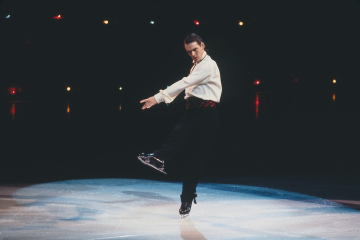
As Curry tentatively began exploring his sexual leanings, he began a relationship with athlete Heinz Wirz. Even though the romantic involvement didn’t last, Curry and Wirz remained lifelong friends and corresponded frequently. Excerpts of their letters are included as voiceovers in the film, the contents of which include telling revelations about Curry’s feelings related to his struggles with managing his sexuality and mental health, both during his days of competition and as a professional.
These issues impacted Curry’s skating endeavors, especially those related to his sexuality. In an interview before his Olympic victory, he spoke candidly about it with a reporter, who publicly outed the skater 24 hours after his win. Curry confirmed the eyebrow-raising reports shortly thereafter, a courageous move at the time. It nevertheless made him the first openly gay Olympian to come out.
Curry subsequently embraced his sexuality, but, unfortunately, he fell victim to the emerging AIDS crisis. Over the next few years, due to the financial difficulties of his troupe and his failing health, his performances trailed off and eventually stopped. As his illness progressed, he retreated into seclusion, passing on in 1994 at the age of 44.
Even though Curry’s career may have been cut short, he left a lasting legacy that changed the sport for years to come. His influence permeated skating, impacting the routines of competitors like Britain’s Robin Cousins, 1980 Olympic and world champion, and American Johnny Weir, three-time US champion and 2008 world’s bronze medalist, both of whom are interviewed in the film about how Curry inspired them. It’s rare when one individual can have such profound impact on changing the course of an art form, but Curry did that, and skating fans can thank him for that.
John Curry faced a number of challenges in his life, both personally and professionally, yet he managed to address many of them successfully. While these ordeals were indeed daunting, Curry summoned up the gumption to take them on. And that occurred primarily because he believed he could overcome them, despite the difficulties, especially where his own insecurities were concerned. That’s important to recognize, because our beliefs dictate how close we come to fulfilling our aspirations, the cornerstone principle of the conscious creation process, the philosophy that maintains we draw upon these intangible resources in manifesting the reality we experience. Even though it’s unclear whether Curry ever heard of this doctrine, it’s apparent through his accomplishments that he was a master of its principles.
Two qualities helped to set Curry apart. First and foremost, he was a visionary when it came to skating. He envisioned what he was trying to achieve – fusing sport and art – and then went out and did it at a time when prevailing conditions were less than conducive for doing so. Athletic and social prejudices governed what was considered acceptable, but Curry’s groundbreaking approach defied those conventions. He was taking a big chance, considering that it was unclear whether the “rebellious” nature of his routines would be embraced in a milieu where tradition persisted and change didn’t come easily.
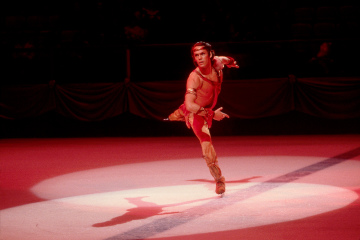
Nevertheless, Curry came out on top in these endeavors, largely because of a second quality – perseverance. Even at those times when he may have wanted to give up – a course that could have easily been facilitated with his mental health issues – he managed to hang in and find the means to follow his dreams. When he struggled financially during his pre-Olympic training, for example, her found a willing sponsor, sports enthusiast Ed Mosler, to bankroll his efforts, including the hiring of the much-in-demand Fassis as his coaches. This enabled him to keep going at a time when it might have been just as easy to walk away.
This combination of vision and perseverance thus made it possible for Curry to live up to his own expectations. And those qualities fell into place thanks to beliefs that made their presence in his own mindset possible. Not only did they help him succeed as a competitive and professional skater, but they also empowered him to grow comfortable in his own skin personally. Allowing oneself to be openly gay at a time when many members of the LGBTQ+ community were still hidden in the recesses of their personal closets, Curry didn’t back off once his secret was revealed. He may not have been comfortable with the way this revelation came about, but he would not allow personal demons, the ghosts of his upbringing or the close-minded thinking of others to continue to hold him back. He had grown comfortable with his orientation and was not afraid to let the world know, an attitude that was surprisingly well accepted at the time and ran far afield from the experiences he underwent while growing up in the shadow of a less-than-tolerant father figure.
The impact of his visionary and persevering beliefs, in turn, made it possible for Curry to tackle another significant obstacle – overcoming his fears and limitations. If he were going to accomplish big things in his life, both professionally and personally, he could not allow these hindrances to block his path, no matter how challenging it may have been in addressing them. In his competitive skating life, for example, he could not let the attitudes of the judges scoring his routines intimidate him. He knew he would have to lay his cards on the table (or, in this case, in the ice) and let the work speak for itself, hoping that his evaluators would be able to see his routines for the bold, inventive statements that they were. Fortunately, they did, and that led to his accolades, which, in turn, enabled him to parlay his award-backed clout into the professional endeavors he went on to pursue. One achievement led to another and then to another that, ultimately and collectively, allowed Curry to persevere and eventually fulfill his vision.
Given that Curry was always progressing in his achievements, on some level, he also seemed to understand that nothing lasts forever, principles that were, again, equally applicable to his professional and personal undertakings. While Curry’s post-competition projects certainly were revolutionary in the world of professional skating, they presented their own sets of challenges that made their perpetuation difficult. Nevertheless, that did not deter him from carrying on, fulfilling one artistic and athletic accomplishment after another, even if they weren’t always replicated more than once.
While those accomplishments were bring fulfilled, however, they represented tremendous achievements, and Curry made the most of them, both individually and with the members of his skating troupe. He relished these attainments, immersing himself in those moments. And, in doing so, Curry embodied the principle that the point of power is in the present. Even if these moments weren’t meant to endure, they incorporated the qualities of grandeur and magnificence during the time while they existed, no matter how brief, producing memorable creations that lasted long after they were over with.
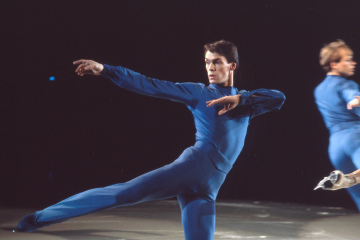
That’s a key concept in conscious creation – that our manifestations represent moments of perfection in their own right, living up to their potential and yielding a thing of intrinsic, even if fleeting, beauty. Their importance should be underscored, though, for they also enabled the ongoing process of personal evolution, something that was quite apparent in Curry’s routines. In this way, Curry’s efforts also reflected the concept that everything is in a constant state of becoming, one of the chief aims of this philosophy. And, in doing so, Curry made it look effortless and inherently beautiful.
One could say that Curry’s life itself embodied the foregoing principles. He virtually disappeared from the skating stage in his mid 30s, well before what many anticipated would be a much longer professional career. And, with his death at 44, Curry as an individual left us at a point that many considered too soon. But, while he was here, Curry made the most of the time he had and lived up to his potential to a degree greater than many of us will ever hope to achieve. His life may have been shorter than expected, but, while he was here, he truly was the Ice King.
Curry revolutionized a sport – and later an art form – that had long been driven by sheer athleticism rather than inspired artistry. But, for all his artistic and athletic achievements, Curry also had to conquer issues that sometimes held him back throughout his life. Director James Erskine’s superb 2018 documentary comprehensively covers all aspects of Curry’s complicated life and death, incorporating a wealth of rare archive footage and featuring insightful commentary from friends, colleagues, and fellow figure skaters Robin Cousins, Johnny Weir and Dorothy Hamill, as well as past interviews with Curry himself. The film is a fitting tribute to a remarkable talent who left a tremendous legacy as a competitor, as an artist, and, above all, as an individual.
The film is available for streaming online from multiple sources. In addition, with the upcoming 2022 Winter Olympics only a few months away, “The Ice King” has been showing up in special screenings in the run-up to the games. No matter how or where one sees it, though, it’s definitely worth the time.
Going for the gold is a metaphor we’re all familiar with, one that applies to more than just the Olympics. Curry applied that notion to all the ventures he undertook and found the means to make those goals possible. The example he set is one that we can all draw from in our own endeavors, regardless of the stage on which those adventures unfold. And, when armed with that kind of inspiration, there’s no telling what we might accomplish, achievements that might well enable us to skate away with medals all our own.
Copyright © 2021, by Brent Marchant. All rights reserved.
With the arrival of fall, we’re heading into film festival and movie awards season. Find out what lies ahead on the next edition of The Good Media Network’s Frankiesense & More video podcast with yours truly and special guest host Danielle Findlay. Tune in Thursday September 30 at 1 pm ET on Facebook Live by clicking here for a lively discussion of releases worth seeing in theaters, via streaming and at film festivals. And, if you don’t see the show live, catch it later on demand!

Tune in for the latest Cinema Scribe segment on Bring Me 2 Life Radio, Tuesday, September 28, at 2 pm ET, available by clicking here. And, if you don't hear the show live, catch it later on demand on Spreaker, Spotify, Apple, iHeartRadio, Google Podcasts, Castbox, Deezer, Podchaser and Jiosaavn.
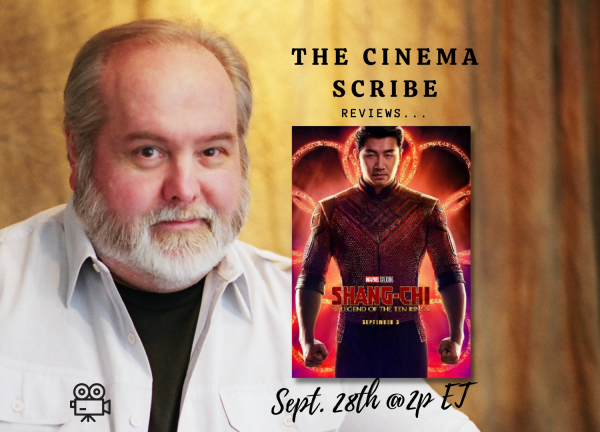

“The Eyes of Tammy Faye” (2021). Cast: Jessica Chastain, Andrew Garfield, Cherry Jones, Vincent D’Onofrio, Sam Jaeger, Mark Wystrach, Fredric Lehne, Louis Cancelmi, Gabriel Olds, Chandler Head, Jay Huguley, Randy Havens, Dan Johnson. Archive Footage: Ronald Reagan, Ted Koppel, Tom Brokaw, John Chancellor, Garrick Utley, Maria Shriver. Director: Michael Showalter. Screenplay: Abe Sylvia. Source Material: Fenton Bailey and Randy Barbato, documentary, “The Eyes of Tammy Faye” (2000). Web site. Trailer.
It’s one thing to be an ardent, committed supporter, but it’s something else entirely to be an unwittingly blind follower. The former reflects a passionate faith and a stern resolve, while the latter is an unquestioned abrogation of one’s personal power. But certainly one can readily make the distinction between those two scenarios, right? Don’t be so sure. Such are the circumstances that characterize the life of a once-powerful and respected television personality as seen in the new, fact-based film biography, “The Eyes of Tammy Faye.”
From almost the time she was born in International Falls, Minnesota in 1942, Tammy Faye LaValley (Chandler Head) sought love, recognition and acceptance. That was hard coming, though, given the shame that was heaped on her by her own mother, Rachel (Cherry Jones), a divorcee who was so embarrassed by her status that she projected it onto her daughter, claiming that Tammy Faye was a reminder of her own “sordid” past. Rachel was so dogmatic about the disgrace of being divorced, in fact, that she wouldn’t even allow Tammy Faye to attend the church where she played piano for fear that her presence in the congregation would serve as a reminder to the parishioners that she was a “fallen woman” (this in spite of the fact that Rachel was married at the time her daughter was born and that she was now wed to her second husband, Fred (Fredric Lehne)). Tammy Faye, meanwhile, desperately wanted to attend services so that she could feel the love of Jesus, the kind of unconditional acceptance that she wasn’t receiving at home. And, when she finally made an appearance at church against her mother’s instructions, she underwent a religious experience that filled her with what had been missing all along, an event that parishioners looked upon as a miracle while Rachel gazed on in consternation.
This experience would come to define Tammy Faye’s character for the remainder of her life. Having now received the acceptance she had long been looking for, it was easy for her to return the favor in kind to others, a belief that essentially enabled her to love everyone. This outlook thus led an adolescent Tammy Faye (Jessica Chastain) to her calling as a charismatic disciple of Christ, enrolling as a student at North Central Bible College in Minneapolis. It’s there where she met an aspiring young evangelist named Jim Bakker (Andrew Garfield), who preached a gospel that maintained Jesus wanted His followers to live lives of abundance and prosperity, not poverty and suffering. This uplifting message captivated the impressionable young Tammy Faye, and she was eager to follow Jim in what he was setting out to do, a goal made easier after they married in 1961.
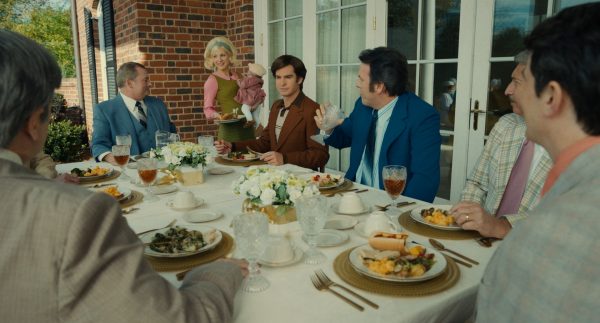
Before long, Jim and Tammy Faye took their ministry on the road, holding prayer meetings across the American South. Jim preached his message, while Tammy Faye sang and staged Christian puppet shows for children. After several years, they took their message to television, becoming long-time fixtures on the Christian Broadcasting Network (CBN), the religious TV empire founded by evangelist Pat Robertson (Gabriel Olds), serving as hosts of The 700 Club, a Christian talk show, and Jim and Tammy, a popular children’s show.
As the Bakkers’ reputation began rising, they became part of an inner circle of powerful evangelists, most notably Jerry Falwell (Vincent D’Onofrio), head of the Moral Majority and co-founder of Liberty University. Falwell unapologetically promoted a “traditional values” agenda that was pro-life, pro-family, anti-gay and segregationist in nature. And, given the clout that leaders like Robertson and Falwell commanded, Jim seemed willing to go along with their views if it would help to advance his cause. However, given Tammy Faye’s willingness to embrace all souls, she was reluctant to follow suit; she couldn’t abide by such close-minded thinking.

This marked perhaps the first time when Tammy Faye didn’t blindly follow her husband’s wishes. But, rather than argue with him about their differences in opinion, she instead encouraged Jim to strike out on his own and build his own network, which he subsequently did with the founding of The PTL Club (Praise The Lord) in 1974. This glitzy Christian news and entertainment program featured a variety of guests, provided a showcase for Tammy Faye’s musical talents and put in place a platform for Jim to preach his prosperity gospel. And, as their own prosperity soared during the ’70s and ’80s, Tammy Faye once again blindly went along with whatever Jim wanted, even when it wasn’t necessarily in her own best interests, both personally and professionally.
Despite widely held contentions that the Bakkers were doing great charitable work through their ministry, there were also allegations about where the money was coming from for all of these undertakings – not to mention the funding of their increasingly lavish personal lifestyle. Tammy Faye added her own fuel to this fire by expressing views that ran counter to what most evangelicals held dear. This became most apparent during her emotional on-air interview with Steve Pieters (Randy Havens), an openly gay man suffering from AIDS. Tammy Faye said it was just another expression of her love for everyone, a view that ran afoul of the likes of Falwell, whom Jim was leaning on increasingly to help bail him out of the growing controversy.
When events finally exploded, Tammy Faye had become an emotional wreck, strung out on a cocktail of Diet Coke and Ativan. What’s more, because of Jim’s financial misdeeds, she was facing the loss of virtually all of her wealth and material possessions. And, to make matters worse, claims that Jim had engaged in homosexual affairs arose, shattering whatever remaining romantic feelings she had left for him and leading to divorce (and jail time for her husband) not long thereafter.
After such a dramatic rise, Tammy Faye took quite a hard – and very public – fall. She became a walking punchline, lampooned on many TV talk shows and sketch comedy programs. Her signature heavy facial makeup and teary, emotional speaking delivery provided ample fodder for jokes on everything from tee shirts to newspaper cartoons. Recovering from that kind of humiliation seemed almost impossible. But the resilient Tammy Faye sought to redeem herself, no matter what it took. Most of all, she wanted to continue to let others know that she loved them and that she would do so no matter how much vitriol was flung in her direction. It was a lesson she learned early on in life, and it was one she was not about to give up now.
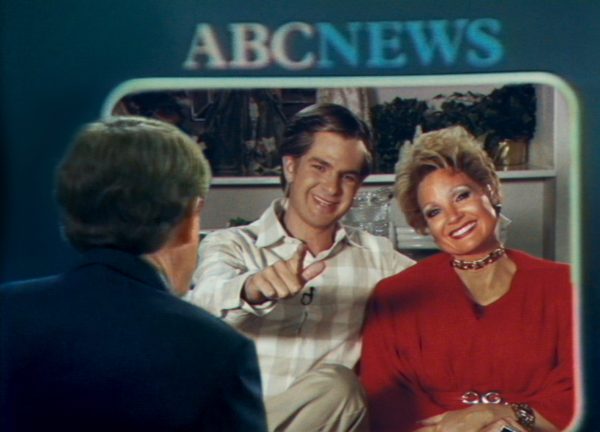
Even though Tammy Faye was subjected to considerable criticism for what happened, both from holier-than-thou conservative constituents and rigidly self-righteous liberal opponents, the film reveals that much of what occurred actually stemmed from guilt by association. By implicitly and naïvely trusting her husband, rarely questioning his actions and willfully looking away when convenient, she ended up in the middle of controversies that were largely not of her own doing, sadly making her a pitiable but sympathetic character.
This is not to suggest, however, that Tammy Faye didn’t err along the way. Those missteps were generally attributable to her vast naïvete, a seemingly boundless Pollyanna attitude fueled by beliefs designed to bring it into being. And that’s crucial to understanding why events unfolded as they did, for our thoughts, beliefs and intents drive the conscious creation process, the philosophy that maintains we draw upon these resources in manifesting our reality and everything found within it. Tammy Faye may have never heard of this school of thought, but her experience certainly shows that she was proficient at practicing its principles.
As the conditions of her childhood show, the obvious lack of love and acceptance that Tammy Faye experienced went a long way into shaping her views about life. She clearly didn’t want to subject others to what she endured, so, when she finally found what was missing through her connection with Jesus, she wanted to freely share that joy and fulfillment with everybody. What’s more, when she met her future husband, who seemingly held a comparable outlook, she gave herself over to him and his plans for their life together.
Noble as these notions may be, however, they weren’t without pitfalls. By treating such beliefs and associated undertakings as implicit absolutes, she stepped into some major traps. For starters, these were ultimately disempowering acts. She ended up surrendering her personal power, regardless of whether she had consciously intended to do so, a commodity that can be difficult to retrieve once lost. On top of this, given her unwavering loyalty and indiscriminately trusting nature, she was willing to follow those whom she believed in, no matter what that may have involved. And that, as the film shows, set her up for trouble.
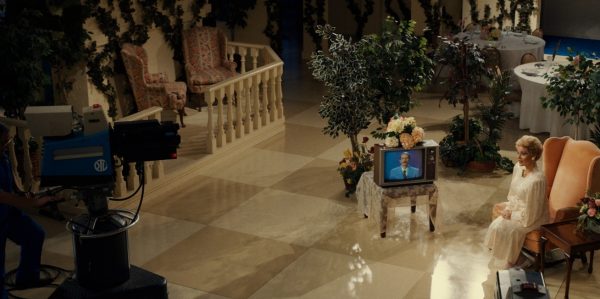
These circumstances illustrate the clear distinction of having faith from practicing blind faith. While there’s much to be said for the former, especially when it comes to forging powerful manifestation beliefs, the latter can lead us down a slippery slope from which recovery can prove to be difficult if not seemingly impossible. Retracting our lost power in these situations is often problematic, partly because we may have come to believe that such a goal is unattainable or that it requires considerable effort to rebuild, which may not be adequate enough in light of what we’re up against.
So what are we to do? Under circumstances like these, the wisest course is not to fall into such traps in the first place. We can do that by making adjustments in our outlooks up front, particularly when it comes to engaging our power of discernment. While adopting qualified beliefs can cause issues, so, too, can adopting them in unqualified, unquestioned forms. Doing so almost suggests an attitude of not caring, as if we couldn’t be bothered to take the time to examine what should be ruled out before recklessly embracing those notions. Such an approach can lead to the practice of un-conscious creation or creation by default, where we’re so preoccupied with following a course at all costs that we ignore what other conditions (including unintended side effects) might accompany our creative initiatives. Tammy Faye, unfortunately, learned this the hard way.

Still, this is not to imply that all is lost either. Redemption and resilience are possible, provided that we believe in those possibilities. Tammy Faye sought this in the wake of her widely publicized downfall, and she managed to bounce back. For example, when Jim lost interest in Tammy Faye and his alleged same-sex dalliances surfaced, she drew others to her to make up for this, such as music producer Gary Paxton (Mark Wystrach) and construction contractor Roe Messner (Sam Jaeger). She knew what it was like to go without love and what it was like to fill that void, skills – backed by suitable beliefs – that she knew how to implement when needed. These undertakings employed those aforementioned qualities of redemption and resilience, and she was able to draw upon the beliefs underlying them – and even transfer them to other aspects of life – when needed. That represented a significant change from the blind faith she practiced earlier in her life and set an impressive example for all of us to follow when we need to make comparable alterations in our own lives.
Rebounding from a humiliating fall from grace may seem like an overwhelming task. But, as director Michael Showalter’s biopic illustrates, turnarounds are not out of the question. The film addresses the many trials and tribulations of the protagonist’s life, most of which are depicted quite capably, though there are a few segments where Jim and Tammy Faye are portrayed more like caricatures than characters, as well as a few others that could have been better focused. Nevertheless, despite these pitfalls, this offering features award-worthy performances by Chastain and Garfield as the celebrated TV couple and Jones as Tammy Faye’s hard-edged, tough-loving mother. It also presents a refreshingly balanced look at the protagonist’s life, poking fun with rapier wit and high camp when needed, but also sincerely painting Ms. Bakker in a surprisingly and deservedly justified sympathetic light. This latest release in the film biography genre may not be perfect, but then neither was Tammy Faye’s notoriously over-the-top makeup routine. In either case, though, that doesn’t mean this release won’t bring a smile – or mascara-laden tear – to your face. “The Eyes of Tammy Faye” has played at several film festivals and is now in general theatrical release.
Going along with what others want without taking a critical look at what’s proposed can be a perilous course. Throwing support behind individuals and causes we care about is certainly fulfilling and ennobling. However, when we cross the line from loyal advocate to unwitting stooge, we veer into troubling territory from which escape can be difficult. That’s why it’s so important that we place faith in ourselves, for it enables us to make valuable distinctions that could end up saving our lives and reputations before all is lost – and perhaps unattainable to retrieve.
Copyright © 2021, by Brent Marchant. All rights reserved.
In case you missed this past week's Mission Unstoppable video podcast interview with Anthony Saldana, director of the award-winning documentary "Straight Off the Canvas," you can now view it on YouTube by clicking here. Tune in for a lively discussion with host Frankie Picasso and yours truly to find out more about this fascinating film.

It’s easy to dismiss certain possibilities as being wholly impossible. But, as life has often shown us, that’s patently lazy, unimaginative thinking. The seemingly implausible can indeed occur with a little adjustment in outlook (and, of course, the accompanying logistics). So it is for a challenged but inspired group of creatives as explored in the uplifting documentary, “Straight Off the Canvas.” Find out more on the next episode of The Good Media Network's Mission Unstoppable video podcast with host Frankie Picasso and yours truly when we interview director Anthony Saldana about his excellent new documentary on the subject, "Straight Off the Canvas." Tune in on Facebook Live Thursday September 16 at 1 pm ET by clicking here.
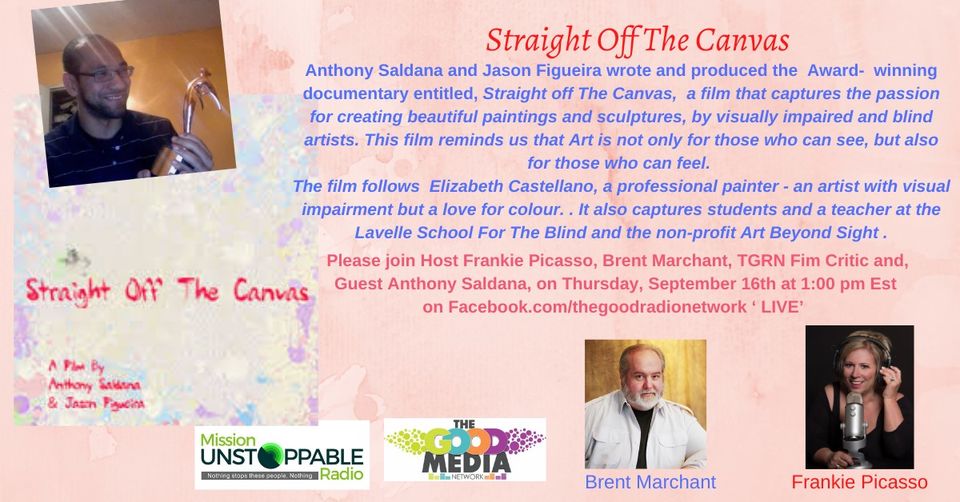
Reviews of "Shang-Chi and the Legend of the Ten Rings," "Straight Off the Canvas" and "The Loneliest Whale: The Search for 52," as well as a film festival preview, all in the latest Movies with Meaning post on the web site of The Good Media Network, available by clicking here.
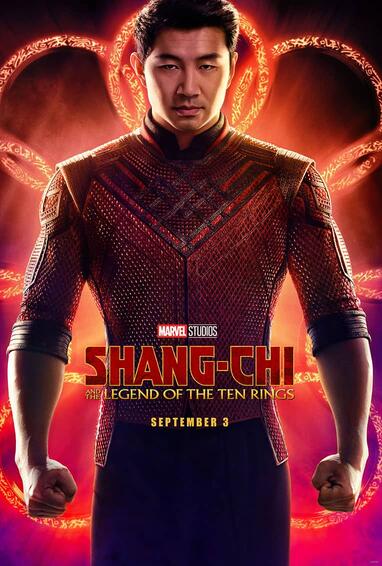
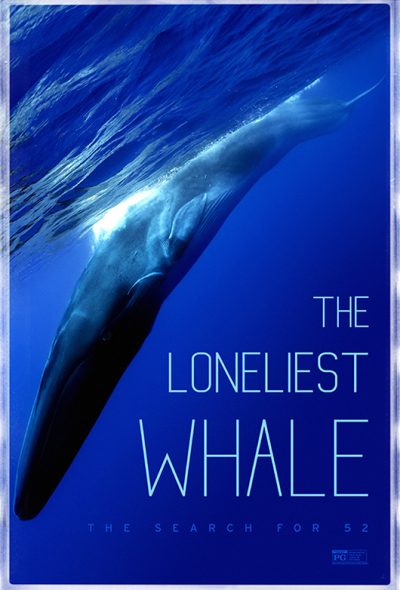




“The Loneliest Whale: The Search for 52”(2020 production, 2021 release). Cast: Joseph George, David Rothenberg, Christopher W. Clark, Bruce Mate, Daniel Palacius, Robert Dziak, Sara Heimlich, Christina Connett, John Hildebrand, John Calambokidis, Ann Sirovic, David Cade, Roger Payne, Graham Burnett, Ann Allen, Kate Micucci, Michael J. Novacek, Vint Virga, Patrick R. Hof, Joshua Zeman (narrator), Bill Watkins (archive footage). Director: Joshua Zeman. Screenplay: Lisa Schiller and Joshua Zeman. Web site. Trailer.
Imagine having something to say, but no one is able to understand you. With no active dialogue or meaningful feedback involved, the “conversation” soon turns one-sided. And, if no responses are forthcoming any time soon, loneliness and sadness are bound to set in. The feeling of isolation this creates could easily become overwhelming. It’s a truly disheartening situation. But, in this case, this scenario isn’t describing something that one of us is experiencing; it’s an account of what might very well be happening to one of our fellows in the animal kingdom, as seen in the touching new documentary, “The Loneliest Whale: The Search for 52.”
During the Cold War, the US Navy established an undersea tracking system to listen for the presence of Soviet subs, the Sound Surveillance System US (SOSUS). According to Joseph George, Retired Chief, US Navy, Integrated Undersea Surveillance System, in the process of listening for these vessels, the system began picking up the sounds of whale songs. These whale sounds were differentiated from those emanated by submarines based on variations in their signal frequencies, specifically their Herz levels. And, over time, with more listening, researchers were able to decipher differences in the frequencies produced by various whale species.
According to Dr. Christopher W. Clark, senior scientist at Cornell University, blue whales sing at a frequency of 100 Herz. Fin whales, by contrast, croon in a rhythmic pattern. And humpback whales, whose elaborate and prolonged songs are perhaps best known, have their own characteristic signature. But, in 1989, a signal was discovered that didn’t fit any of the established patterns, and it appeared to be coming from a single source. As this signal was seemingly the only source of any sounds on this unique 52 Herz frequency, researchers weren’t exactly sure what they had found. It was presumed to be coming from a whale, but it was unlike anything that had ever been discovered before, perhaps even a previously unknown species. In any event, this incident thus marked the beginning of the legacy of “52,” an apparently solitary whale that was somehow singing on its own frequency.
Several years later, oceanographer Bill Watkins isolated the 52 whale and tracked it for 12 years, plotting its migration pattern. But he never undertook a search for it prior to his death, given the unlikelihood of finding a single whale in such a vast expanse of ocean whose believed territory stretched from southern California to Alaska. And, considering that some whale species can cover as much ground as 2,500 miles in a single day, the search would be akin to looking for the proverbial needle in a haystack. Nevertheless, the discovery in itself was considered significant, and the creature was subsequently nicknamed “the Watkins Whale” in honor of the man who found it.
So what exactly was this Watkins whale? Could it be a hybrid, perhaps of a blue whale and a fin whale? Was it a new, previously unknown species? Or was it some other kind of oceanic anomaly altogether? Researchers over the years were curious to find out, but, realistically speaking, they understood the challenges involved, many of which recalled the sentiments expressed by Watkins himself. What’s more, since no one had been tracking 52 for many years, there was also a question about whether the creature was still alive. Even though a number of whale species can live as long as 70 years, there was no indication of how old 52 was when its vocal footprint was first spotted in 1989 and whether it could still be within its hypothetically projected life span. Yet researchers also conceded that perhaps alternative investigative practices could be employed to find 52; after all, they said, with whales, what we hear can often be more revealing than what we see.
As the foregoing illustrates, sound can be quite a telling indicator when it comes to whales. Those curious about looking for 52, notably filmmaker Joshua Zeman and a team of researchers, believed that the classified SOSUS information collected since 52 was last tracked could prove quite helpful to see if its signal had been spotted in the interim. However, for national security reasons, permission to access the data was initially denied. But assistance in obtaining this information soon came from an unlikely source. Robert Dziak, PMEL Acoustics Program Manager for the National Oceanic and Atmospheric Administration, who studies underwater volcanoes using SOSUS data, was able to secure it to aid a new effort to find the Watkins whale.
After a review of the SOSUS data, NOAA scientist Sara Heimlich came across a pattern on the 52 Herz frequency where a signal appeared to be repeatedly emitted in 10-segment bursts. However, even though this may have been a calling card from the whale, the data was determined not to be specific enough. So, if researchers truly wanted to find it, they would have to go look for it.
An effort was thus launched to put together an investigative team. Since it was believed that 52 could be a hybrid of a blue whale and a fin whale (and that it could be travelling in pods made up of either or both of these species), the team sought out experts who were well-versed in their knowledge of these creatures. The investigative crew tapped the expertise of a number of scientists and oceanic specialists, including John Hildebrand, bioacoustics professor at the Scripps Institute for Oceanography at the University of California, San Diego, and John Calambokidis of the Cascadia Research Collaborative. Calambokidis studied blue whales for 35 years and believed he once may have found evidence of a possible hybrid whale that might have been 52, though no sound data was collected at the time to definitively verify this conclusion.
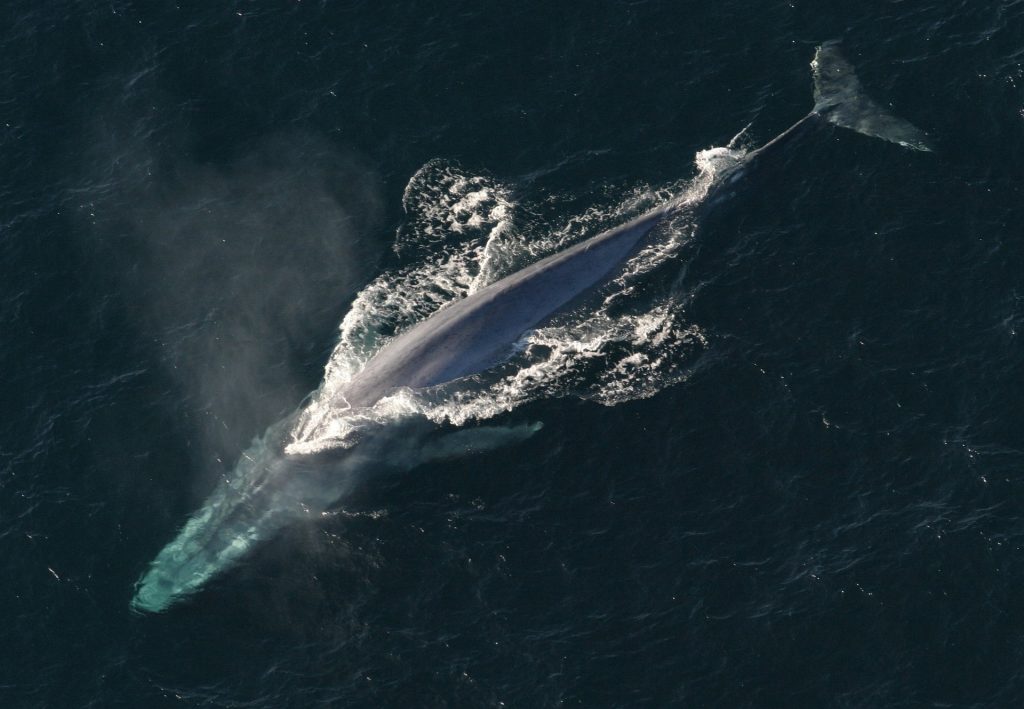
A seven-day search was organized, conducted off the coast of Santa Barbara, California, a chief feeding/migratory path for blue whales, fin whales and humpbacks, 52’s most likely “relatives.” Investigators listened for these species with sonobuoys formerly used by the US Navy, and groups of blue, fin and humpback whales were tagged to see if they could lead the researchers to 52. It was believed that 52 could well have been alone in a whale community. It was also believed that other whales could hear it but couldn’t understand it because of its unique frequency, a circumstance that made 52 “the ultimate outsider.”
All of the interest in 52 naturally raised the question, why were researchers so curious about it? In many ways, this became a story where myth meets science. Many wondered, is the whale itself truly lonely? The question itself even began to be celebrated in story and song, a fable that somehow struck a chord with people, including those outside the scientific community. Many found themselves becoming sympathetic to the whale’s plight. How lonely it must be for that creature. But, then, given troubling developments in human society in recent years related to breakdowns in our own communication, listening and interaction practices, this sentiment somehow resonated with us. We could appreciate what 52 might be going through, because we had been going through it ourselves to greater and more disturbing degrees.
Cetacean researchers have found in their studies of whales and dolphins that these animals are highly intelligent. Neuroscience professor Patrick R. Hof, for example, says that whales have cellular structure in their brain physiology supporting this idea, as well as a sense of sentience and self-awareness. What’s more, animal psychologist Vint Virga observes that whales are also highly social beings as evidenced, for example, by the existence and structure of their communities. And, when one puts all of these ideas together, could that indeed make the case that 52 might genuinely be lonely? If we can sense that, and if we know firsthand what those conditions might be like, then perhaps there’s a viable basis for believing it to be true where the Watkins whale is concerned.
Obviously there’s more to this story than just a search for a scientific curiosity, even if the exact nature of the investigation is difficult to pinpoint. Perhaps it’s the search itself that’s what matters most. Maybe our quest to find 52 is a metaphor to find ourselves, especially when it comes to locating the parts of ourselves that are missing, filling voids that are desperately in need of being filled. Indeed, what we’re looking for and what 52 may be looking for could be the same thing, and that’s a concept we can relate to and identify with. If we can find 52, then maybe there’s a way we can help one another to give us and it what’s needed – and to overcome the oppressing loneliness.
The story of 52 is a touching one in many ways. It’s truly astounding how a film – particularly a documentary – can evoke such a genuine emotional response for a being that’s not a fellow human. But the parallels in our respective circumstances cry out for our attention, for the insights we glean from the whale’s story have benefits for us as well. And, when we come to believe that, we begin to realize that the creature’s experience could indeed be a cautionary tale for the rest of us.
Such beliefs, in turn, are important for the impact they have in shaping the nature of our reality, the outcome of the conscious creation process, the philosophy that maintains we draw upon these resources in manifesting our existence. If we can relate to the qualities that characterize 52’s situation, we can’t help but ask ourselves, do we really want to end up the same way? Do we truly want to live in a world where we’re unable to connect and communicate with others, especially when we seem to be unwittingly yet intentionally creating circumstances that bring about such a result? Indeed, perhaps we’re so drawn to this saga because we don’t want to end up living under the same conditions, and 52’s experience can help to make us aware of that possibility before it’s too late. It’s one thing to assert our individuality, but it’s something else entirely to do so by becoming loners.
There are a number of stories involving whales over the years that have helped or could be helping us to come to comparable realizations, several of which are addressed in the film. For instance, at one time, man hunted whales indiscriminately, bringing a number of species to the brink of endangerment or even possible extinction. But, as Roger Payne of the Ocean Alliance points out, once humanity was made aware of the intelligence of these creatures (thanks to the popularization of recordings of whale songs in the 1970s), we had a drastic change of heart. How could we possibly think about callously killing these beings? In fact, how could we realistically think about doing that to any of the other species that occupy this planet with us? Whales helped teach us that lesson, enabling us to change our beliefs and their associated outcomes, and we have them to thank for it. Indeed, as Payne put it, “When people care, they can change the world.”
Even if the foregoing enabled us to drastically change the course of history, that’s not to say we don’t still have work to do, and whales are again showing us what needs to be done. Oceanic sound pollution, for example, could be inhibiting 52’s ability to communicate with its kindreds, but researchers have come to discover that this is actually a growing issue for all whales. Sound distortions created by freighters, submarines and underwater explosions conducted to search for new oil reserves all lead to confusion for the whales, especially those whose feeding territories overlap with the areas from which these sounds emanate. This can cause such problems as whales being mutilated and killed when they become entangled with the propellers of boats they’re unable to avoid in time. This issue is thus depriving whales of their native habitats and their natural ability to communicate, and we’re responsible. These incidents could be aimed at helping to make us aware of the problem and enabling us once again to change our beliefs while we still have the chance, not only for the whales’ sake, but also a means to help preserve and protect our own environment.
As director Zeman observes, the relationship between man and whales hasn’t always been an easy one. This is perhaps nowhere more apparent than in Herman Melville’s famous novel Moby Dick, in which the obsessed Captain Ahab was determined to defeat his allegedly demonic nemesis, the great white whale, at any cost. But, as science has shown since the penning of that work, the notion that whales could be looked upon in that light is a huge fallacy, one of mankind’s greatest follies driven by ignorance and the beliefs that back it up. Now that we know more, however, we can drop those erroneous convictions and enable ourselves to embrace more enlightened principles like respect, tolerance and keeping an open mind until we know all the facts. In fact, Ahab’s experience illustrates the potential danger in falling prey to obsessions of any kind, not just those associated with recklessly killing whales. Yet this is another case where it’s taken a whale’s tale to help us come to that realization. (Who says these undersea creatures don’t know a thing or two?)
As the whales continue their work with us as teachers, there are other areas in which they can help us. For instance, 52’s tale is a key example when addressing our collective connection and communication issues, helping us mend the needlessly severed ties with our human tribe. But they can also work with us individually, helping us to learn personal lessons of great importance, depending on our particular interaction with them. In that regard, they can thus become mentors for us, enlightening us to heartfelt individual insights that can help us with our own personal growth and development, not unlike what the “kindly” tiny mollusk did for filmmaker Craig Foster in the Oscar-winning documentary “My Octopus Teacher” (2020). Perhaps 52, in its own way, is doing the same for us, both individually and en masse.
Perhaps the greatest takeaway for us from this film is that, in line with conscious creation philosophy, the world around us is a reflection of our inner selves. That includes all the creatures that share this reality with us, and our cetacean cousins’ presence is to help remind us of that. They reinforce the idea of connecting with one another, both among fellow humans and across species lines. They make clear that we must be responsible, accountable stewards of our environment (indeed, of the entirety of our reality as creators of it). And they show us, by way of the examples they set within their own pod communities, that we must all get along with one another if any of us hope to survive. Let’s hope we’re listening to more than just their enchanting melodies.
The search for connection is something that we all understand, not only as a social practice, but also as a personal and collective need, and this film effectively conveys that message. The mythology that has emerged about this enigmatic creature is thus more than just a sweet and sentimental tale, with insights that are clearly presented and shared in a thoughtful and straightforward, but by no means dogmatic, manner. The film also provides a detailed, captivating and beautifully filmed, though not excessively technical, account of the seven-day expedition to search for the cetacean social outcast. The picture’s sidebar stories are fascinating, too, even if often introduced somewhat awkwardly. The insertion of a number of somewhat self-aggrandizing observations from the director admittedly impedes the flow of the narrative at times, but the picture’s other strengths make up for this, especially its metaphorical parables that we had all better heed if we hope to save the whales – and ourselves.
After a brief theatrical run in early summer, “The Loneliest Whale” has since become available for streaming online. Viewers should be cautioned, however, not to confuse this offering with “Fathom,” another documentary about whales available for streaming that was also released over the summer – and did a far less successful job in telling its story. If it’s whales you’re looking for, 52’s story is the one to watch.
As much as humans like to think of themselves as the most advanced species occupying this world, it’s undeniable we still have much to learn, and the fellow residents of this place we call Earth obviously have much to teach us, as 52’s experience illustrates. We should be grateful for their presence – and their companionship – for joining us on this journey. Not only do they make it more enjoyable, but they also enlighten us, helping to make the world a better place for all of us.
Copyright © 2021, by Brent Marchant. All rights reserved.
Tune in for the latest Cinema Scribe segment on Bring Me 2 Life Radio, Tuesday, September 14, at 2 pm ET, available by clicking here. And, if you don't hear the show live, catch it later on demand on Spreaker, Spotify, Apple, iHeartRadio, Google Podcasts, Castbox, Deezer, Podchaser and Jiosaavn.
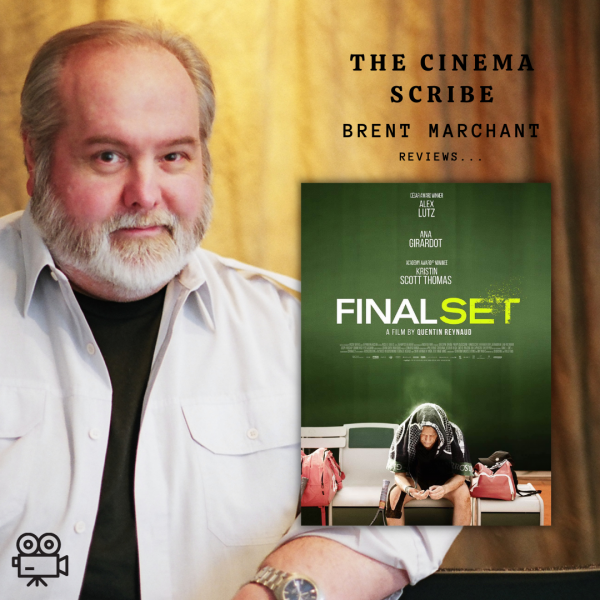

“Straight Off the Canvas”(2020). Cast: Elizabeth Castellano, Jessica Jones, Sarah Valeri, Elizabeth Axel, Nicole Flores, Francis Rivera, Katherine Gelchinsky, the art students of the Lavelle School for the Blind. Director: Anthony Saldana. Screenplay: Jason Figueira and Anthony Saldana. Web site.
It’s easy to dismiss certain possibilities as being wholly impossible. But, as life has often shown us, that’s patently lazy, unimaginative thinking. The seemingly implausible can indeed occur with a little adjustment in outlook (and, of course, the accompanying logistics). So it is for a challenged but inspired group of creatives as explored in the uplifting documentary, “Straight Off the Canvas.”
How many of us have given thought to the notion that blind or visually impaired individuals can become artists? How can they possibly “visualize” a finished product that they can’t see or possibly even envision it in the same way that the sighted do? It may seem completely unlikely, but, as director Anthony Saldana’s film illustrates, it’s not only possible but has indeed happened.
“Straight Off the Canvas” profiles a number of blind artists and art teachers who have succeeded in their odds-defying efforts. This material is supplemented by interviews with professionals and advocates who work with these creatives to help inspire them or to develop workarounds for issues that might present logistical problems. And the results are nothing short of amazing.
Elizabeth Castellano, for instance, is a painter and former art teacher who was born blind. She gained some sight with a corneal transplant as a teen, but her visual capabilities were still far less than a typical sighted person. Nevertheless, she was inspired by the drawings of her childhood friend Katherine Gelchinsky and was determined to follow suit, becoming something that most everyone thought she could never do. As she experimented with painting styles over the years, she learned after a time that her visual impairment could actually influence and even characterize her own form of artistic expression, one that’s more emotive than realistic. In fact, she admits, becoming too realistic in her work would expose the impairment and undermine her style’s inherent singular validity.
Jessica Jones is a teacher at New York’s Lavelle School for the Blind who majored in the arts in college, but she went blind as a result of diabetic retinopathy in adulthood. She carries on, though, showing other aspiring blind artists how to fulfill their potential. She says she gets the greatest joy out of art when she’s making items to be given as gifts or when she’s teaching others (especially visually impaired kids) to become artists in their own right.
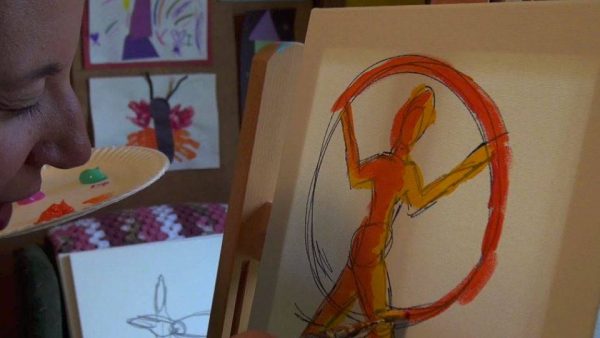
As these artists and art therapist Sarah Valeri have discovered, though, some adjustments are needed to help aspiring painters live up to their potential. For example, when it comes to the concept of “color,” how does one express it only verbally? How does one who’s unsighted understand the difference between orange and purple? And how does one relate the idea to someone who can’t differentiate and/or perceive color in the same way as someone sighted? Valeri says it needs to be expressed as a feeling, not as a visual (or purely verbal) description. Comparing yellow to warmth or red to passion, for example, helps to convey these notions without ever seeing these hues firsthand. Similarly, creating a sample board of swatches of different materials helps to convey an awareness of different types of textures and the feelings they invoke, notions that can then be translated into artistic expressions.
According to Elizabeth Axel, creative director of Art Beyond Sight, bridging the gap between aspiring blind artists and a sighted world that takes its visual capabilities for granted is crucial to help these individuals fulfill their dreams. She stresses the need to overcome the limitations that the sighted community has set for what constitutes “visual art.” These assumptions need to be supplemented with notions that are more inclusive, making it possible for art to be understood and appreciated in additional ways. For example, “accessible” museums – those that encourage a more tactile experience of art – are an effective way of accomplishing this, offering tremendous therapeutic value for those who are blind and still want to be able to appreciate the qualities of art that the sighted enjoy.
As the film clearly points out, the foregoing illustrates some of the widely held misconceptions about what the blind are capable of. Drawing on a scene from D.W. Griffiths’s film “Orphans of the Storm” (1921), for instance, director Saldana shows how attitudes about blindness became rooted, established and reinforced in the thinking of the sighted world. Blindness, the Griffith film asserts, renders someone helpless, a condition equivalent to the powerlessness, vulnerability and dependence of a newborn baby. In addition to robbing the blind of their sense of personal empowerment, this outlook proved to be a damaging, close-minded notion for art, because it made art into something considered in visual terms only. And the visually impaired and their advocates have been battling that stigma ever since.
Would-be blind artists need to be reassured that there is no right or wrong when it comes to creating, assessing or appreciating art. Helping the visually impaired understand this draws attention to the importance of art therapy, a practice that connects the mental, emotional and physical aspects of art, creating a wholeness built on these traits and providing a safe milieu for expressing oneself. And, with suitable modifications and adaptations, limitations to achieving these goals can easily be overcome.
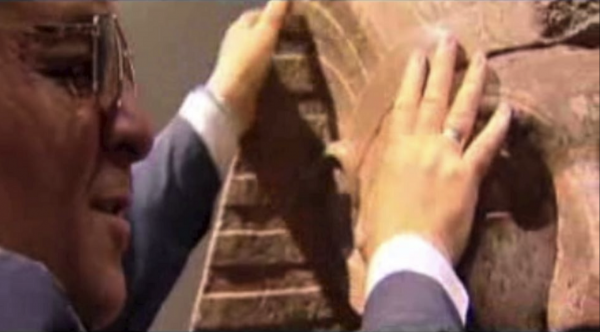
This also illustrates the importance of making adept teachers available to instruct artistic aspirants, a sentiment summed up in the film by a quote from visionary Albert Einstein: “It is the supreme art of the teacher to awaken joy in creative expression and knowledge.” Good teachers are crucial to helping would-be artists becoming actual artists, a blessing that truly inspired Castellano to launch her artistic vocation and to become a teacher in her own right. This is especially true where blind art teachers are concerned, for they have the ability to inspire blind students, giving them someone to identify with. These teachers can draw from their own experience in telling their kids “You can do this.” What’s more, blind teachers aren’t limited to instructing blind students; those who are talented enough can effectively instruct the sighted as well.
In addition to these timeless themes, the film includes a segment rooted in contemporary conditions – the practice of art under quarantine. COVID-19 has impacted all of us in numerous ways, and it has imposed additional challenges upon those with special needs, like the visually impaired. When those conditions are added to the already-challenging circumstances that blind artists (and particularly blind child artists) must face, the importance of providing further adaptations to their artistic and teaching practices surfaces. As the artists in the film explain, art helps people cope with the conditions of the pandemic, especially during confinement. That’s especially true for students who are separated from their teachers and from one another under these conditions. Thus it has become critical to be able to adjust tactics as needed. But, then, as the film shows, that’s nothing new for the visually impaired.
The importance of art in our lives can’t be underestimated. Indeed, the need to create is essential to our existence – and that’s true for all of us. The personal value and self-worth that come from our individual artistic expression gives our lives meaning as contributors to the human condition – and as a calling card to let others know we’re here.
The very notion of a visually impaired individual becoming an artist may seem outlandish, even foolhardy. Yet here are examples of people who have said no to the naysayers. The fact that they have succeeded in their quests suggests that they’ve had visionary experiences in which they have overcome their handicaps to become practitioners of their art. Some would likely even go so far as to say that they don’t possess handicaps at all but that they’ve been imbued with special gifts to further distinguish their craft in their own singular ways.
Such is what happens when one believes in the possibility, the product of the conscious creation process, the philosophy that maintains we manifest the reality we experience through the power of our thoughts, beliefs and intents. It’s unclear whether any of them, including the individuals profiled in this film, have ever heard of this school of thought, but it’s apparent from their output that they have become proficient in managing and mastering a number of its key principles.

For starters, they have been able to envision outcomes that would seem to defy most expectations. That’s a crucial starting point, for if they’re able to picture the destinations they’re seeking, it’s only a matter of time before the beliefs follow to make those outcomes happen. Indeed, if one can dream it, one can create it; all it takes is filling in some of the blanks that fall in between, backed by beliefs that suit those needs.
Perhaps the biggest challenge individuals in these circumstances must face is coming up with beliefs that overcome the limitations standing in their way. This will likely call for making necessary adaptations, which, in turn, may require regular thinking outside the box. However, since creatives often tend to deal with the unconventional, that shouldn’t be particularly difficult in most cases. The inventiveness and innovation that they employ in coming up with their finished pieces are often the same qualities that they can draw upon in solving the logistical problems that arise along the way. All they need do is tap into that mindset, and the necessary beliefs are once again sure to follow.
What’s perhaps most crucial for these artists is the example they’re able to set, not only for other blind individuals, but also for anyone seeking to become an artist. They inspire and motivate other aspirants, and they add beauty and creativity to a world very much in need of it (especially these days). That’s quite a contribution in itself. And, when we see what they can do, we might well forget that they’re starting from a position that’s more challenging than most of us would ever face.
“Straight Off the Canvas” is indeed an inspiring and educational offering, one that will surprise many viewers every step of the way. And, for that accomplishment, the film has won 13 awards in film festival and other competitions, taking home the prize every time it has been nominated. Director Anthony Saldana has compiled a fine film, one that he looks to promote as an instructional tool to help advance the cause of blind artists through screening licenses and DVD sales targeted at educational institutions, including universities, schools, museums and nonprofit organizations. It’s always heartening to see a picture that does more than just entertain, and this release does just that.
To find out more about “Straight Off the Canvas,” tune in to the September 16 edition of The Good Media Network’s Mission Unstoppable video podcast with host Frankie Picasso and yours truly. We’ll interview director Anthony Saldana to learn how the documentary came together and where he takes it from here. Catch us on Facebook Live at 1 pm ET by clicking here, followed by a recorded rebroadcast on YouTube.
It’s been said that “A thing of beauty is a joy to behold.” Considering how the works of these artists were created, that goes double here. And, thanks to this film, we have the opportunity to discover that for ourselves.
Copyright © 2021, by Brent Marchant. All rights reserved.

“Shang-Chi and the Legend of the Ten Rings” (2021). Cast: Simu Liu, Tony Leung, Awkwafina, Meng’er Zhang, Fala Chen, Michelle Yeoh, Ben Kingsley, Yuen Wah, Florian Munteanu, Benedict Wong, Andy Le, Jayden Chang, Elodie Fong, Arnold Sun, Kunal Dudheker, Stephanie Hsu, Jodi Long, Tsai Chin. Director: Destin Daniel Cretton. Screenplay: Dave Callahan, Destin Daniel Cretton and Andrew Lanham. Story: Dave Callahan and Destin Daniel Cretton. Source Material: Steve Engelhart and Jim Starlin, Marvel Comics. Web site. Trailer.
Who we are and how we determine that can be an arduous undertaking, one replete with doubt, uncertainty and even denial. But, if we’re to attain satisfaction and fulfillment in life, it’s a process we must all go through to discover just what makes us, us. No one’s immune from this either, not even those who possess seemingly superior powers that one might think would automatically come with greater self-awareness. Such is the dilemma faced by a reluctant superhero in the thrilling and thoughtful new action-adventure saga, “Shang-Chi and the Legend of the Ten Rings.”
Successfully running away from a troubled past may seem like an expedient and effective way of escaping it, but appearances can definitely be deceiving. So it is for Chinese immigrant Xu Shang-Chi (Simu Liu), who fled his homeland to find hoped-for peace of mind in San Francisco. He spends his days as a parking valet and knocking around with his friend and co-worker, Katy Chen (Awkwafina). However, it’s readily apparent that they’re both slumming it in their current occupations; they’re both vastly intellectually and academically overqualified to be parking cars for a living. So why are they doing it?
In a sense, Katy and Shang-Chi (who has now Americanized his name as “Shaun”) are both hiding from – and searching for – themselves. Katy is trying to duck from her overbearing mother (Jodi Long), who clearly wants her daughter to follow a traditional lifestyle as a wife and mother, something Katy knows she doesn’t want, despite an obvious uncertainty about what to replace it with. As for Shaun, his choice to hide from himself is also a deliberate decision, one to withdraw from his past, something he rarely talks about. Yet there’s definitely more to Shaun and who he is than he lets on, something that becomes unexpectedly and startlingly exposed.
One morning, while Shaun and Katy are riding the bus to work, he’s approached by a band of thugs seeking to steal a green pendant that he never takes off. The necklace was a gift from his deceased mother, Li (Fala Chen), who told him that it would always help him find his way home if he ever got into trouble. Given the sentimental value of this piece of jewelry (and the secret power he suspects it possesses), Shaun refuses to give it up, and a fight ensues that makes the battle scenes in most kung fu movies pale by comparison. As Katy and stunned onlookers stand agape at what unfolds – most notably Shaun’s never-before-seen fighting expertise – the bad guys are systematically taken out, including a muscle-bound Romanian hunk named Razor Fist (Florian Munteanu), whose missing right hand has been replaced with an appendage befitting his name. But, in the midst of the conflict, Shaun discovers the pendant is missing, apparently snatched by the thugs as they made their escape.
When all is said and done, Katy is dumbfounded by what happened, prompting her to coax Shaun to come clean about what happened. It’s at that point when she (and viewers) learn of her friend’s mysterious past. Shang-Chi grew up with a once-powerful, self-serving father, Xu Wenwu (Tony Leung), who spent a millennium amassing wealth and virtually limitless power thanks to his command of 10 magical rings that he found (and never took off). That outlook changed, however, when the supreme master met Li, the only person capable of defeating him in battle, something she did by winning over his heart. Wenwu’s prevailing attitude changed from one of greed to one of loving benevolence, a new perspective that led to marriage and the birth of two children, Shang-Chi (Jayden Chang) and his sister, Xialing (Elodie Fong). But, when Li died, Wenwu was so heartbroken that he began reverting to his old ways, even training his teenage son (Arnold Sun) to become a reluctant assassin, a role than Shang-Chi clearly did not want to play. So, when his father gave him his first assignment, Shang-Chi used the opportunity to flee to America, never looking back.
Now, however, with the theft of the pendant, Shang-Chi realizes that his father has discovered where he has been hiding when he learns that dad dispatched his henchmen to grab the jewelry – and to send a message. He also knows that his now-adult sister (Meng’er Zhang), who is still living in China, is also likely in danger, especially since she possesses a matching pendant, one that, if paired with the stolen item, might unleash tremendous powers that could spell trouble for more than just him and Xialing.
Realizing what he must do, Shang-Chi departs for China. And Katy, who believes she had nothing to lose by tagging along, joins him as they go in search of his sister to warn her. But the journey turns out to be nothing what they expect as they encounter a highly self-sufficient Xialing, along with an ever more determined Wenwu and his army of minions, including the infamous Razor Fist. Their odyssey subsequently takes Shang-Chi, Xialing and Katy far afield from the world they’ve grown accustomed to, including forays into mysterious territory akin to the mythical Shangri-La, where they meet great warriors, magical creatures, a has-been actor (Ben Kingsley) and long-lost family members, such as their wise and courageous aunt, Ying Nan (Michelle Yeoh). It proves to be quite the adventure, one that tests everyone’s character and beliefs – and enables the trio of young adults to at last find themselves.
Like many films in this genre, in the process of discovering himself, Shang-Chi comes to the realization that he’s a bona fide superhero. But, more than that, like many comparable origin story films, he finds his authentic self, his mission in life, his reason for being. And that happens because he begins to believe in that notion. Those beliefs make it possible, just as they do in virtually every other manifestation scenario thanks to the conscious creation process, the philosophy that maintains we draw upon those resources in materializing the existence we experience.
This is something of a challenging road for Shang-Chi, because, on some level, he knew this about himself all along but seemed to willfully deny it. The memories of his troubled upbringing after his mother’s death most likely contributed significantly to this. When his anguished father began reverting to his old ways and starting training his son to use his abilities for nefarious purposes, this imposed change of course in Shang-Chi’s life did not set well with him. His mother lovingly taught him to use his abilities for beneficial purposes, just as she did when she swayed Wenwu to change his ways. But, when Li was no longer in the picture to guide him, Shang-Chi fell under the influence and tutelage of his father, who set an example that was anything but honorable and caused the idealistic teen to hide his true feelings for fear of severe ridicule from his dad. And, when Shang-Chi made his escape to America, he put his past behind him, including any desire to use his abilities benevolently. Shaun retreated into himself and shut the door tightly behind him.
Such barriers can stay in place for only so long. At some point, the focus required to form the beliefs needed to erect and maintain those barricades – even though intangible – becomes overwhelming, and what they’re designed to hold back can no longer be contained. Circumstances will arise to liberate what’s been “artificially” restrained, hence the encounter with Wenwu’s goons that led to Shaun’s transformation back into Shang-Chi.
As the story unfolds, it becomes apparent that Shang-Chi is not the only one going through an evolutionary growth spurt. Katy follows suit, leaving behind her old life to find her own authentic self as well. To a great degree, this involves getting out from under her mother’s thumb. But that’s not all; as a somewhat immature wild child, she needs to find something to focus on, something with a purpose, an undertaking that will allow her to channel her beliefs into something meaningful, useful and purposeful. And, as her odyssey takes shape, it involves more than just being Shang-Chi’s sidekick; she looks for and finds a way to liberate her own authentic self.
Interestingly, both Shang-Chi and Katy draw considerable inspiration from Xialing. When the long-separated siblings reconnect, Shang-Chi finds that his baby sister has grown quite self-reliant in her own right, in many ways more so than her brother. When Shang-Chi learns how she accomplished this, he’s duly impressed, given that she made use of her abilities at the same time he was abandoning his own. Xialing’s experience thus gives Shang-Chi a source of encouragement and motivation to draw upon, not only in his words and deeds, but also in the beliefs he adopts to forge a new path for himself, enabling his true superhero self to emerge and prosper.
In addition to following such inspiration, Shang-Chi learns how to rid himself of beliefs that no longer serve him, specifically those associated with fears, limitations and allowing the ghosts of his past to dictate the course of his life. That’s a crucial step for anyone working the manifestation process, for such hindrances keep us locked in place and prevent us from creating what we desire. At the same time, this also calls for a willingness to accept and embrace change. New beliefs are obviously called for when the old ones no longer function, so anyone looking to move forward must be comfortable with this step as well. That may not be easy, given how many of us tend to resist change at almost any cost, but it’s essential for forward progress to occur.
Once Shang-Chi understands all of the foregoing issues, he comes to see that he’s at last able to live out his destiny, a practice that conscious creators often call exercising their value fulfillment, being our best, truest selves for the betterment of ourselves and those around us. Being a superhero is obviously what Shang-Chi was meant to do. But his path in discovering that may be a little more challenging than for others embracing their destinies. His circumstances heavily involve his readiness and ability to choose that course. Shang-Chi’s destiny is not simply handed to him; he has to want to pursue it and take the steps needed to make it happen. Fortunately, he has plenty of wherewithal and inspiration to help bring that about, an outcome that truly is super.
For a film that I wasn’t especially looking forward to, this latest offering from the Marvel Universe certainly surprised me. While the trailer appeared to bill this as little more than a grandiose martial arts movie, director Destin Daniel Cretton’s latest has an epic quality about it, presenting a story that’s mythic in nature and infused with themes related to morality, personal evolution and coming into one’s own, qualities not often found in releases like this. The picture is essentially an origin story piece in the same vein as “Captain Marvel” (2019) and “Black Panther” (2018), with a narrative that mirrors both of these cinematic predecessors but with better overall execution, especially in the writing and pacing. Besides its captivating story and well-orchestrated (though generally not overdone) action sequences, this offering features ample comic relief, unexpected touches of whimsy and surprisingly good performances, especially from Awkwafina, Yeoh and Kingsley. While the film’s closing act is admittedly a little too drawn out, that’s a small price to pay for everything else it has to offer. “Shang-Chi” is easily one of the best films of the summer season and one of the finest additions to the Marvel Universe to come along in quite some time. Action-adventure fans will surely enjoy it, but even those generally less drawn to this genre will likely come away from this one having had a good, uplifting and entertaining time. The film is currently playing in theaters.
Living up to our potential can be one of the most daunting journeys we’ll ever embark upon. It brings us face to face with the core of our being, forcing us to deal with our true selves, whether we like it or not. We might even try to shy away from it, thinking it’s beyond our capability to deal with. But, once we realize that’s who we really are, it becomes easier to accept and to make peace with it. And, with such an alignment in place, there’s no telling what we might achieve. Who knows – we might even save the world. And wouldn’t that be fun.
Copyright © 2021, by Brent Marchant. All rights reserved.
In case you missed this past week's Mission Unstoppable video podcast interview with Patrick Sammon and Bennett Singer, directors of the engaging new documentary "Cured," you can now view it on YouTube, available by clicking here. Tune in for a lively discussion with host Frankie Picasso and yours truly to find out more about this fascinating new film.
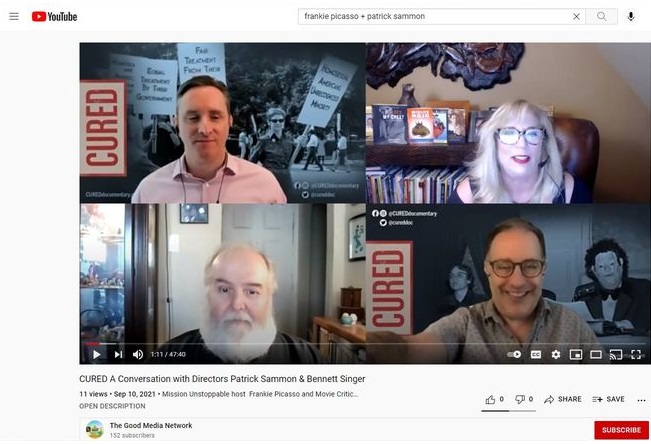
I'm pleased to announced the the makers of the excellent documentary "Cured" have excerpted portions of my review of their film on their website. Scroll down to the bottom of the reviews list by clicking here. My thanks to the filmmakers for including me. And, to hear more from directors Patrick Sammon and Bennett Singer about their film, click here.


Reviews of "Respect," "Cured" and "Final Set," as well as podcast, blog and magazine article previews, are all in the latest Movies with Meaning post on the web site of The Good Media Network, available by clicking here.
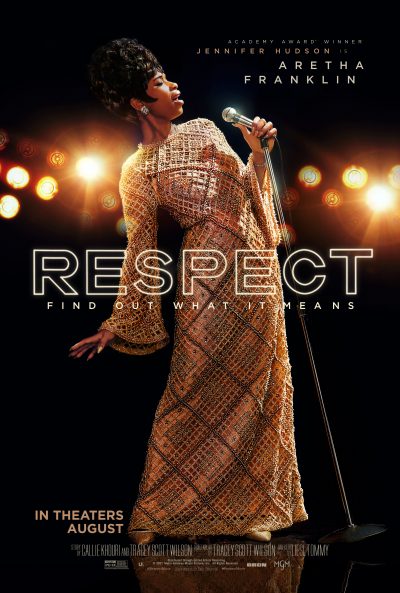
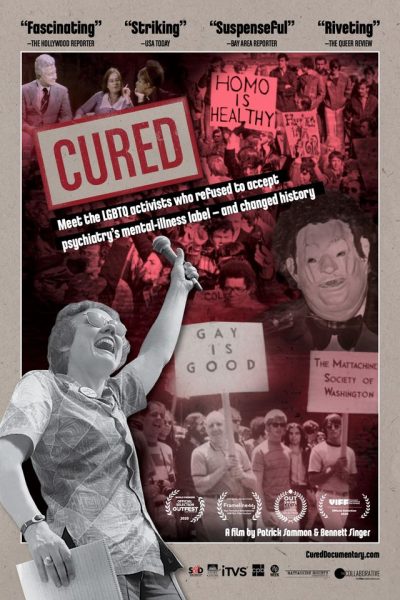




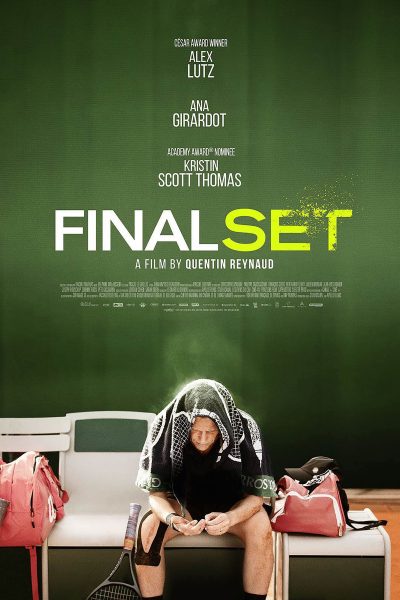
How can millions of allegedly mentally ill individuals be "cured" of their conditions overnight with the stroke of a pen? That's what LGBTQ+ activists were able to achieve in 1973, when they successfully convinced the American Psychiatric Association to reject homosexuality as an alleged form of mental illness. How did they do that? Find out on the next episode of The Good Media Network's Mission Unstoppable video podcast with host Frankie Picasso and yours truly when we interview directors Patrick Sammon and Bennett Singer about their excellent new documentary on the subject, "Cured." Tune in on Facebook Live Thursday September 9 at 1 pm ET by clicking here.


“Final Set”(“Cinquième set”) (2020 production, 2021 release). Cast: Alex Lutz, Ana Girardot, Kristin Scott Thomas, Jürgen Briand, Quentin Reynaud, Alexandre Angelo Bettanini, Yanaïs Laurent, Victor Ouvrard, Leny Mitjana, Tariq Bettahar, Fabienne Galula, Thierry de Carbonnières. Director: Quentin Reynaud. Screenplay: Quentin Reynaud. Web site. Trailer.
When we move toward – or pass – our prime, we may begin to look upon ourselves and our accomplishments with some dismay, especially if we haven’t lived up to expectations. With the clock ticking ever faster, we might well view our circumstances with melancholy and disappointment, no matter how well or how poorly we may have done. But we need not be stuck with a grim future or a legacy of regret. Comebacks are indeed possible, as seen in the new French sports drama/character study, “Final Set”(“Cinquième set”).
Thirty-seven-year-old French tennis star Thomas J. Edison (Alex Lutz) is facing an uncertain future. The onetime teen phenom has watched two decades of competition fly by without achieving the payoff he was expected to realize. In recent years, his aging body has begun to fail him, necessitating several knee surgeries followed by ongoing rigorous physical therapy. But, prior to that, Thomas had other problems to contend with, most notably wrestling with demons of never living up to his potential. Consequently, he’s spent most of his peak playing years frustrated, waiting for a break that has never come.
To make matters worse, during that time, he’s been under constant pressure from the sports press, routinely bombarded with harsh denunciation over his failure to perform. And, at times, he’s also been hit with comparably cruel criticism from sources closer to home, most notably his disapproving mother, Judith (Kristin Scott Thomas), owner of a prominent Paris tennis club, who has been relentlessly disappointed that her own flesh and blood has let her down in a profession in which she is herself so heavily invested. So much for motherly love.
Given his age, physical condition and track record, Thomas is now squarely staring down the end of his career, despite his often-pathetically forlorn protests to the contrary. He’s having increasing trouble making the cut for tournaments (even lesser-known ones) and, consequently, not being taken seriously. And, on top of this, he’s also having to sit back and watch the rise of a new teenage superstar, fellow French countryman Damien Thosso (Jürgen Briand), a player often compared to a young Edison – but without the unfortunate habit of cracking under pressure.

Despite his dogged determination to carry on, there are those in Thomas’s life who wouldn’t mind seeing him slow down and prepare for retirement. That’s particularly true of his wife, Eve (Ana Girardot), a onetime tennis player who has given up the sport to pursue other interests, such as going back to school. Given the new direction in her life, she could use more help around the house, especially in caring for their young son, Gaspard (Alexandre Angelo Bettanini). She’s also concerned that Thomas may be seriously deluding himself about what lies ahead, particularly the slim hope of him ever attaining the success that has always eluded him – and that he’s not likely to achieve in the playing time he has left. The growing strain in their relationship does not bode well for the future of their marriage.
However, Thomas is not about to give up, despite the physical and mental challenges, not to mention all the criticisms, no matter where they come from. After rejections from several tournaments, he decides to make a run at competing in the prestigious French Open, an event in which he has a chance (albeit slight) at qualifying by playing in several preliminary rounds. It’s a long shot, to be sure, but, if he focuses on his game and the breaks fall his way, he just might experience a breakthrough. It would also be a source of redemption for Thomas, given that this same tournament marked the beginning of his downward spiral, choking at a critical point in the competition. It was a devastation from which he never recovered, but now maybe he has an opportunity to make up for that – and to show others that the potential never went away; it just took time to surface.
Much to everyone’s surprise, Thomas is unexpectedly successful. Commentators and sports journalists are quick to note that he’s playing much the same way he did in his youth. For his efforts, he even lands the backing of a commercial sponsor (Fabienne Galula). But, despite such success, the strain continues to grow between Thomas and Eve, just at a time when he could use her support most. And, just when it seems like things couldn’t get any more tense, he learns who his next opponent will be – Damien Thosso. It’s match that will not only test his abilities, but it will also bring him face to face with his own past, taking on an opponent the same age he was when everything fell apart. What outcome can he expect this time?

When we’re convinced that it’s possible to achieve a particular objective, no matter what the odds, that’s a prime example of determination at work. Yet, in the face of such circumstances, many would likely look at us and think we’re daft. But somehow we’re convinced that carrying on is an attainable goal.
Why is that? Is it a reasonable assessment? Wishful thinking? Lunacy run amok? More than anything else, it’s a belief in ourselves and our abilities, one based on supreme confidence and backed by a boatload of courage. And recognizing the significance of that belief is crucial, for it drives the conscious creation process, the philosophy that maintains we manifest the reality we experience through the power of those intent-based resources.
The determination Thomas exhibits is quite evident and only grows stronger as his story unfolds. He genuinely believes he can accomplish what he’s set out to do, despite the drawbacks and the criticisms that have been so freely heaped upon him. In fact, the criticisms could even be helping him by making him more determined, more committed to seeing through on his ambitions, no matter how Quixotic they may appear to others.
That belief in oneself is important to anyone undertaking a particular venture, especially one with long odds. It provides the motivation necessary to carry forward, regardless of what we may be up against. Even if we experience setbacks along the way, that steely resolve often provides the drive and energy to continue, to find ways to rebound from errors and overcome obstacles on the path to arriving at our chosen destination. Thomas embodies this concept in virtually all of his efforts to continue competing and capture the prize he so concertedly seeks.
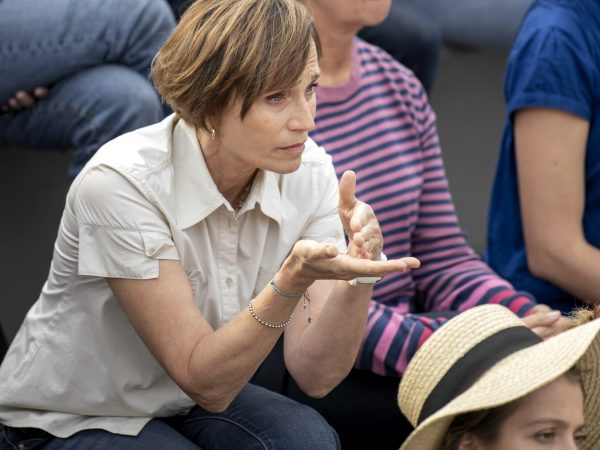
To put oneself into such a state of mind, though, there are other challenges to be surmounted. Most notably there’s the need to face our fears and get past them. As with anything we manifest as conscious creators, fear is something that can be materialized or dispensed with, depending, again, on our beliefs. If we allow fear-based beliefs to hold sway over us, we’ll never attain our goals, for those apprehensions will undermine our efforts at every turn, essentially cancelling our intents, no matter how strongly we hold onto them.
The solution, of course, is to embrace beliefs that are the antithesis of our fears. By choosing to live courageously, we eliminate the apprehensions that would otherwise hold us back. In fact, those empowering heroic sentiments can even energize us, impelling us to ever greater heights of success and attainment. Fewer things can motivate someone seeking to achieve than a courageous outlook, especially when confronted by naysayers spouting the contrary. And, as Thomas plays his way through the Open’s qualifying rounds, he begins to clearly see that for himself.
What’s perhaps most important to recognize in all this is that it’s never too late for a comeback. When we reach a certain point in our lives and careers, many of us embrace various assumptions about ourselves, most of them having to do with giving up hopes of ever returning to previous levels of capability and the prospects of recapturing them. But that only need be the case if we adopt beliefs related to those notions. As Thomas often points out in the film, there are a number of tennis players who achieved their greatest successes at ages older than he is now. Granted, their examples may not be the norm, but fulfilling such achievements is indeed possible, and Thomas would like to believe that he’s one among them. As long as he holds fast to those convictions, he just might succeed. It’s an example that we can all follow, too, whether we’re tennis players, ballerinas or practitioners of any other adventurous endeavor. And it’s comforting to know that the game may not be over when most of us tend to think it’s ended.

This is particularly noteworthy for those of us seeking to redeem ourselves for past failures. Those previous disappointments may have taken quite a toll on us. They may have discouraged us from continuing to try. Or they may have haunted us for years as we’ve resolutely sought to saunter on, constantly reminded of our shortcomings. And, through it all, we may have continually wondered whether we’ll ever live up to what we know we’re capable of. But getting another chance – and believing we’ll succeed at it – can wipe away all of those frustrations, offering us the redemption we’ve long sought. Could that be what’s awaiting Thomas? He’ll soon find out.
It’s easy for sports movies to fall into the trap of being corny, clichéd and trite. However, director Quentin Reynaud’s second feature takes the genre a step further, serving up an engaging, thoughtful character study about a determined but aging French tennis star seeking a comeback and redemption. While some elements of the story are a little repetitive and occasionally predictable, the film nevertheless offers viewers a fresh take on issues like drive, obsession and the price we’re willing to pay to realize a cherished goal, no matter what the milieu. The picture’s fine performances, ethereal score and artfully filmed tennis matches mix well, adding to a narrative that seeks to go beyond the expected and ordinary. “Final Set” definitely delivers more than what one might anticipate, advancing a genre that all too often takes the easy route. The film is playing theatrically and online.
Finding our way back to who and what we once were may be a challenging venture. In fact, we may not succeed at it either. But we’ll never know if we never make the attempt. If nothing else, there’s something to be said for the effort. Just as Thomas seeks to make a storied comeback, what truly matters most is that we undertake the endeavor, regardless of how it turns out. And one can hardly find fault with that.
Copyright © 2021, by Brent Marchant. All rights reserved.